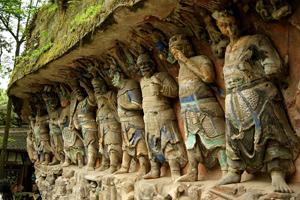Chongqing City Tour Packages
Dazu Rock Carvings
The Dazu Rock Carvings
contains all the cliffside carvings in Dazu County. The
collection is composed of the rock carvings in Beishan,
Baodingshan, Nanshan, Shimenshan as well as Shizhuanshan,
all of which are of the highest artistic attainment and
demonstrate the most exquisite skills.
Dazu County, reputed as 'the county of rock carving' is
located at the southeast of Sichuan province. It is 271
kilometers (about 168.4 miles) from
Chengdu on its west and
167 kilometers (about 103.8 miles) from
Chongqing on its east.
The whole county has an area of 1,400 square kilometers
(about 540.5 square miles), and it covers a history of
1,230 years since it came into existence in 758 during
the Tang Dynasty (618-907).
The Dazu Rock Carvings was built from 650 in the Tang
Dynasty and continued to the Ming Dynasty (1368-1644)
and the Qing Dynasty (1616-1911). It is as famous as the
Mogao Cave in Dunhuang, Gansu Province. The rock
carvings in these places are very distinguished both at
home and abroad. Among the rock carvings, there are more
than 5,000 statues and over100, 000 Chinese characters
of inscriptions and epigraphs. The Buddhist statues
dominate in this rock carving group, and the Taoist and
the Confucian stone figures can also be seen.
Beishan Rock Carving:
It is 2 kilometers (about 1.24 miles) away from the
northwest of Dazu County. Figures in this part are
something like 'an Assembly of Oriental Beauty', since
it enjoys good preservation and elaborate craftsmanship.
Tourists can see the graceful statue of Samantabhadra
Bodhisattva, crowned as 'The Oriental Venus'. Rock
carvings in this part reveal the common Buddhist faith.
Standing here for a while, one may feel that it is
really a Buddhist palace.
Baodingshan Rock Carving:
It is 15 kilometers (about 9.32 miles) from the
northeast of Dazu County. It is made up of 13 groups of
stone carving figures, totaling nearly 10 thousand
cliffside figures. In this part, magnificent rock
figures in different shapes compose a story. One will
see some original and ethnic Buddhist rock features.
Nanshan Rock Carving:
Standing at the southeast of Dazu County, the Taoism
doctrine is the main theme in this part. Taoist gods'
figures are carved vividly .The cave of Sanqing
demonstrates the Taoist gods' ranking in the Song
Dynasty (960-1279). Therefore, tourists will be
impressed by these colorful clay creations.
Shizhuanshan Rock Carving:
This section is 25 kilometers (about 15.5 miles) far
from the southwest of Dazu County. The niche of
Confucius and that of Lao Tzu can be seen here
.Buddhist, Taoist and Confucius statues are integrated
in this part which is quite rare in Chinese grotto art.
Shimenshan Rock Carving:
Apart 20 kilometers (about 12.4miles) from the eastern
part of Dazu County, the Shimenshan Rock Carving
combines Buddhist and Taoist statues, but the later one
predominates. In addition to these stone figures, there
are also some inscriptions and remarks beside the
figures. Representaion of some gods' figures are
lifelike and vivid. For example, outside the niche of
the Great Jade Emperor stands the statuary of Shun Feng
Er meaning 'Favorable Wind Ears' which looks as if he is
looking into the distance and the figure of Chien Li Yen
meaning 'Thousand League Eyes' which looks as if he is
listening to attentively.
Many statues show the Buddhist and the Confucius
doctrines, particularly the filial piety. In 1999, the
Dazu Rock Carving was ranked as a World Cultural
Heritage Site. Every year many thousands of tourists
from home and abroad pay it a visit.
Travel Tips:
You may take a bus at the Caiyuan Ba, Chongqing
Municipal to the Dazu County Bus Station (CNY 45). There
are two bus stations at the Dazu County, one for long
distance another for short distance which is the one to
the spot area. After arrival at Long-Distanced Bus
Station of the Dazu County two hours later, you may hire
a rickshaw (CNY 2) to the Short-Distanced Bus Station.
Then taking a bus to the Baodingshan (CNY 3) will take
you twenty minutes and later you will arrive the
entrance of this spot. At last you will take a rickshaw
to the ticket office of the spot.
|

